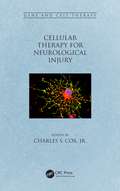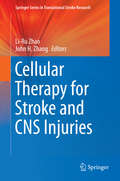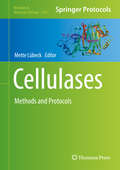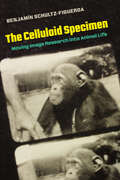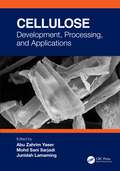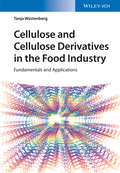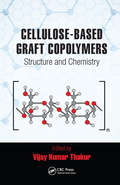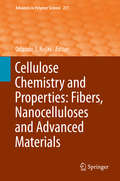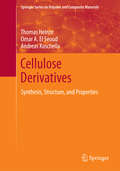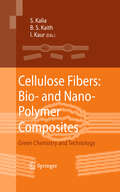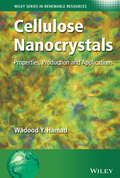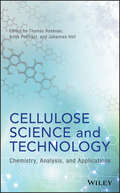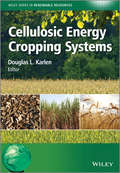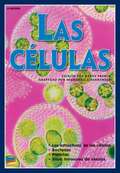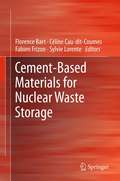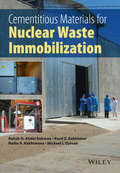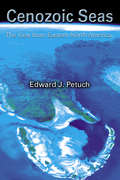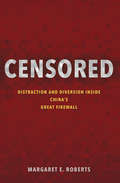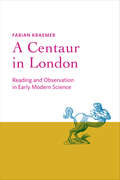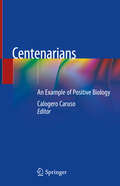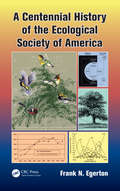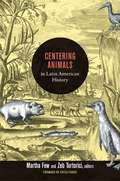- Table View
- List View
Cellular Solids
by Lorna J. Gibson Michael F. AshbyIn this new edition of their classic work on Cellular Solids, the authors have brought the book completely up to date, including new work on processing of metallic and ceramic foams and on the mechanical, electrical and acoustic properties of cellular solids. Data for commercially available foams are presented on material property charts; two new case studies show how the charts are used for selection of foams in engineering design. Over 150 references appearing in the literature since the publication of the first edition are cited. The text summarises current understanding of the structure and mechanical behaviour of cellular materials, and the ways in which they can be exploited in engineering design. Cellular solids include engineering honeycombs and foams (which can now be made from polymers, metals, ceramics and composites) as well as natural materials, such as wood, cork and cancellous bone.
Cellular Therapies for Retinal Disease: A Strategic Approach
by Robert Lanza Steven D. Schwartz Aaron NagielThis book familiarizes the reader with the current landscape of cell-based therapies for the treatment of retinal disease, including diseases that affect the choriocapillaris, retinal pigment epithelium, photoreceptors, and retinal ganglion cells. Instead of utilizing a disease-centric approach to the topic, this book--edited by two world-renowned stem cell scientists--focuses on strategies for developing and transplanting the cells. This includes the creation of replacement cells, cell-based neuroprotection, and in vitro disease modeling and testing. The final chapters briefly review parallel approaches that do not directly utilize cellular transplantation. The use of cellular transplantation to treat retinal disease has recently become a viable and exciting therapeutic approach. The visibility of the retina and its laminar cellular architecture render it an ideal organ for the development of surgically delivered cellular therapies. Having an in-depth understanding of the current state of cell therapy for the eye is an essential first step toward utilizing similar approaches in other organs. Ophthalmologists, translational clinician-scientists, stem cell scientists, and researchers interested in eye disease will find Cellular Therapies for Retinal Disease: A Strategic Approach essential reading and it is also suitable for workshops or courses at the undergraduate or Ph. D. level.
Cellular Therapy for Neurological Injury (Gene and Cell Therapy)
by Charles S. Cox Jr.Cellular Therapy for Neurological Injury discusses the current status of cellular therapy for neurological disorders. The primary areas of focus include traumatic brain injury, stroke (ischemic and hemorrhagic), and spinal cord injury. The book explores cell therapy approaches to these and other conditions, while discussing current advances and a l
Cellular Therapy for Stroke and CNS Injuries (Springer Series in Translational Stroke Research)
by John H. Zhang Li-Ru ZhaoCellular therapy for stroke and neural trauma has gained worldwide attention during the last decade and has shown some promising results. Various cells, including neural stem cells, bone marrow stem cells, endothelial progenitor cells, and many others have had protective or regenerative effects in animal models. The proposed book will address recent research on all relevant cell types. In addition, it will provide information on cell isolation and culture skills, transplantation methods, and neurological functional evaluations. This is the first book to focus on cellular therapy for stroke and other CNS injuries.
Cellular Trafficking of Cell Stress Proteins in Health and Disease (Heat Shock Proteins #6)
by Brian Henderson A. Graham PockleySince the beginning of the 21st Century there has been a rapid increase in our understanding of the cellular trafficking mechanisms of molecular chaperones in eukaryotes and in prokaryotes. In the former, molecular chaperone trafficking can occur between the various cellular compartments, with concomitant movement of other proteins. Such events can also result in the release of molecular chaperones from cells. In bacteria, molecular chaperones are involved in the trafficking of other proteins and are themselves released into the external milieu. The increasing appreciation of the role of molecular chaperones and Protein-Folding Catalysts in the interplay between bacteria and the cells of their hosts is now an important area of research for understanding the mechanisms of infectious diseases. This volume brings together experts in the biochemistry, cellular biology, immunology and molecular biology of molecular chaperones and Protein-Folding Catalysts with a focus on the mechanisms of cellular trafficking of these proteins and the role of these variegated trafficking mechanisms in both human and animal health and disease.
Cellulases: Methods and Protocols (Methods in Molecular Biology #1796)
by Mette LübeckThis volume discusses the latest research and techniques used to study novel cellulases. The chapters in this book explore topics such as the role of cellulases in lignocellulose deconstruction for generation of a sugar platform for biofuel; screening for novel fungal b-glucosidases in a variety of fungal strains; discovery of novel enzymes in bacteria or fungi; protocols for isolating cellulolytic rumen bacteria; analysis of enzyme mixtures produced by ligocellulolytic fungi; and homology modeling. Written in the highly successful Methods in Molecular Biology series format, chapters include introductions to their respective topics, lists of the necessary materials and reagents, step-by-step, readily reproducible laboratory protocols, and tips on troubleshooting and avoiding known pitfalls.Cutting-edge and thorough, Cellulases: Methods and Protocols is a valuable resource for biochemists, molecular biologists, chemical engineers, and industrial researchers interested in this field.
The Celluloid Specimen: Moving Image Research into Animal Life
by Benjamin Schultz-FigueroaA free ebook version of this title is available through Luminos, University of California Press’s Open Access publishing program. Visit www.luminosoa.org to learn more. In The Celluloid Specimen, Benjamín Schultz‑Figueroa examines rarely seen behaviorist films of animal experiments from the 1930s and 1940s. These laboratory recordings—including Robert Yerkes's work with North American primate colonies, Yale University's rat‑based simulations of human society, and B. F. Skinner's promotions for pigeon‑guided missiles—have long been considered passive records of scientific research. In Schultz‑Figueroa's incisive analysis, however, they are revealed to be rich historical, political, and aesthetic texts that played a crucial role in American scientific and cultural history—and remain foundational to contemporary conceptions of species, race, identity, and society.
Cellulose: Development, Processing, and Applications
by Abu Zahrim YaserCellulose: Development, Processing, and Applications covers topics related to advanced cellulose development and processing, as well as the utilization of major agricultural and biomass waste. It discusses the utilization of cellulose from other agricultural and biomass materials, including oil palm biomass, bamboo, and other non-wood forest products in emerging areas. It covers the treatments used to improve the quality of cellulosic materials in specific applications. Following that, the book delves into the use of cellulosic materials in the application of composting science and technology. Features: Delves into the specific agriculture waste/biomass waste materials used for the advanced cellulose-based production Outlines the potential use of the covered materials for energy production and other emerging applications Includes composting technology and processes using the cellulosic materials Overviews industrial applications of cellulose from agricultural waste/biomass waste and composting technology Discusses the main agricultural waste/biomass in the Asian region This book is aimed at researchers and graduate students in chemical engineering, bioprocessing, composites, and biotechnology.
Cellulose and Cellulose Derivatives in the Food Industry
by Tanja WuestenbergAuthored by an expert with many years of experience as an application engineer at renowned cellulose processing companies in the food industry, this book presents all the conventional and latest knowledge available on cellulose and its derivatives. Throughout, the necessary details are elucidated from a theoretical and practical viewpoint, while retaining the focus on food applications. The book provides an essential source of informations including recommendations and instructions of a general nature to assist readers in the exploration of possible applications of cellulose and its derivatives and the generation of new ideas for product development. Topics include gelling and rheological properties, synergistic effects with other hydrocolloids, as well as nutritional and legal aspects. The resulting compilation covers all the information and advice needed for the successful development, implementation, and handling of cellulose-containing products.
Cellulose-Based Graft Copolymers: Structure and Chemistry
by Vijay Kumar ThakurCellulose-Based Graft Copolymers: Structure and Chemistry discusses the synthesis, characterization, and properties of multifunctional cellulose-based graft copolymers. Presenting the contributions of accomplished experts in the field of natural cellulosic polymers, this authoritative text: Offers an overview of cutting-edge technical accomplishmen
Cellulose Chemistry and Properties: Fibers, Nanocelluloses and Advanced Materials (Advances in Polymer Science #271)
by Orlando J. RojasVincent Bulone et al. : Cellulose sources and new understanding of synthesis in plants Thomas Heinze et al. :Cellulose structure and properties Thomas Rosenau, Antje Potthast, Ute Henniges et al. : Recent developments in cellulose aging (degradation / yellowing / chromophore formation) Sunkyu Park et al. :Cellulose crystallinity Lina Zhang et al. :Gelation and dissolution behavior of cellulose Yoshiyuki Nishio et al. :Cellulose and derivatives in liquid crystals Alessandro Gandini, Naceur Belgacem et al. :The surface and in-depth modification of cellulose fibers Emily D. Cranston et al. :Interfacial properties of cellulose Herbert Sixta, Michael Hummel et al. Cellulose Fibers Regenerated from Cellulose Solutions in Ionic Liquids Qi Zhou et al. :Cellulose-based biocomposites Orlando Rojas et al. :Films of cellulose nanocrystals and nanofibrils Pedro Fardim et al. :Functional cellulose particles Wadood Hamad et al. :Cellulose Composites
Cellulose Derivatives
by Thomas Heinze Omar A. El Seoud Andreas KoschellaThis book summarizes recent progress in cellulose chemistry. The last 10 years have witnessed important developments, because sustainability is a major concern. Biodegradable cellulose derivatives, in particular esters and ethers, are employed on a large scale. The recent developments in cellulose chemistry include unconventional methods for the synthesis of derivatives, introduction of novel solvents, e.g. ionic liquids, novel approaches to regioselective derivatization of cellulose, preparation of nano-particles and nano-composites for specific applications. These new developments are discussed comprehensively. This book is aimed at researchers and professionals working on cellulose and its derivatives. It fills an important gap in teaching, because most organic chemistry textbooks concentrate on the relatively simple chemistry of mono- and disaccharides. The chemistry and, more importantly, the applications of cellulose are only concisely mentioned.
Cellulose Fibers: Green Chemistry and Technology
by Susheel Kalia B. S. Kaith Inderjeet KaurBecause we are living in an era of Green Science and Technology, developments in the field of bio- and nano- polymer composite materials for advanced structural and medical applications is a rapidly emerging area and the subject of scientific attention. In light of the continuously deteriorating environmental conditions, researchers all over the world have focused an enormous amount of scientific research towards bio-based materials because of their cost effectiveness, eco-friendliness and renewability. This handbook deals with cellulose fibers and nano-fibers and covers the latest advances in bio- and nano- polymer composite materials. This rapidly expanding field is generating many exciting new materials with novel properties and promises to yield advanced applications in diverse fields. This book reviews vital issues and topics and will be of interest to academicians, research scholars, polymer engineers and researchers in industries working in the subject area. It will also be a valuable resource for undergraduate and postgraduate students at institutes of plastic engineering and other technical institutes.
Cellulose Nanocrystals: Properties, Production and Applications
by Wadood Y. HamadResearch into cellulose nanocrystals is currently in an exponential growth phase, with research into potential applications now strengthened by recent advances in nanomanufacturing. The possibility of routine commercial production of these advanced materials is now becoming a reality. Cellulose Nanocrystals: Properties, Production and Applications provides an in-depth overview of the materials science, chemistry and physics of cellulose nanocrystals, and the technical development of advanced materials based on cellulose nanocrystals for industrial and medical applications. Topics covered include: • A comprehensive treatment of the structure, morphology and synthesis of cellulose nanocrystals. • The science and engineering of producing cellulose nanocrystals and the challenges involved in nanomanufacturing on a large industrial scale. • Surface/interface modifications of cellulose nanocrystals for the development of novel biomaterials with attractive structural and functional properties.• The scientific bases for developing cellulose-based nanomaterials with advanced functionalities for industrial/medical applications and consumer products. • Discussions on the (i) reinforcing potential of cellulose nanocrystals in polymer nanocomposites, (ii) utilization of these nanocrystals as efficient templates for developing tunable photonic materials, as well as (iii) applications in sustainable electronics and biomedicine. Cellulose Nanocrystals: Properties, Production and Applications will appeal to audiences in the physical, chemical and biological sciences as well as engineering disciplines. It will be of critical interest to industrialists seeking to develop sustainable new materials for the advanced industrial economies of the 21st century, ranging from adaptive “smart” packaging materials, to new chiral, mesoporous materials for optoelectronics and photonics , to high-performance nanocomposites for structural applications.
Cellulose Science and Technology: Chemistry, Analysis, and Applications
by Thomas Rosenau Antje Potthast Johannes HellThis book addresses both classic concepts and state-of-the-art technologies surrounding cellulose science and technology. Integrating nanoscience and applications in materials, energy, biotechnology, and more, the book appeals broadly to students and researchers in chemistry, materials, energy, and environmental science.• Includes contributions from leading cellulose scientists worldwide, with five Anselm Payen Cellulose Award winners and two Hayashi Jisuke Cellulose Award winners• Deals with a highly applicable and timely topic, considering the current activities in the fields of bioeconomies, biorefineries, and biomass utilization• Maximizes readership by combining fundamental science and application development
Cellulosic Energy Cropping Systems
by Douglas L. KarlenCellulosic Energy Cropping Systems presents a comprehensive overview of how cellulosic energy crops can be sustainably produced and converted to affordable energy through liquid fuels, heat and electricity.The book begins with an introduction to cellulosic feedstocks, discussing their potential as a large-scale sustainable energy source, and technologies for the production of liquid fuels, heat and electricity. Subsequent chapters examine miscanthus, switchgrass, sugarcane and energy cane, sorghums and crop residues, reviewing their phylogeny, cultural practices, and opportunities for genetic improvement. This is followed by a detailed focus on woody crops, including eucalyptus, pine, poplar and willow. Critical logistical issues associated with both herbaceous and woody feedstocks are reviewed, and alternate strategies for harvesting, transporting, and storing cellulosic materials are also examined. The final sectionof the booktackles the challenge of achieving long-term sustainability, addressing economic, environmental and social factors.Cellulosic Energy Cropping Systems is a valuable resource for academics, students and industry professionals working in the field of biomass cultivation and conversion, bioenergy, crop science and agriculture.Topics covered include:Identifying suitable cellulosic energy crops that are adapted to a wide range of climates and soilsBest management practices for sustainably growing, harvesting, storing, transporting and pre-processing these cropsThe development of integrated cellulosic energy cropping systems for supplying commercial processing plantsChallenges and opportunities for the long-term sustainability of cellulosic energy crops This book was conceived and initiated by David I. Bransby, Professor of Energy and Forage Crops in the Department of Crop, Soil and Environmental Sciences at Auburn University, USA. For more information on the Wiley Series in Renewable Resources, visit www.wiley.com/go/rrs
Cement-Based Materials for Nuclear Waste Storage
by Céline Cau-di-Coumes Sylvie Lorente Fabien Frizon Florence BartAs the re-emergence of nuclear power as an acceptable energy source on an international basis continues, the need for safe and reliable ways to dispose of radioactive waste becomes ever more critical. The ultimate goal for designing a predisposal waste-management system depends on producing waste containers suitable for storage, transportation and permanent disposal. Cement-Based Materials for Nuclear-Waste Storage provides a roadmap for the use of cementation as an applied technique for the treatment of low- and intermediate-level radioactive wastes. Coverage includes, but is not limited to, a comparison of cementation with other solidification techniques, advantages of calcium-silicate cements over other materials and a discussion of the long-term suitability and safety of waste packages as well as cement barriers.
Cementitious Materials for Nuclear Waste Immobilization
by Michael I. Ojovan Nailia R. Rakhimova Ravil Z. Rakhimov Rehab O. Abdel RahmanCementitious Materials for Nuclear Waste Immobilization
Cenozoic Seas: The View From Eastern North America
by Edward J. Petuch>The rich fossil record of the Atlantic and Gulf coastal plains of the United States is a gold mine for interested scientists. The last thirty million years of Earth history are superbly chronicled by a succession of fossil assemblages extending from the St. Lawrence River to Florida. Marine scientists, paleontologists, and systematic biologists al
Censored: Distraction and Diversion Inside China`s Great Firewall
by Margaret E. RobertsA groundbreaking and surprising look at contemporary censorship in China <P><P>As authoritarian governments around the world develop sophisticated technologies for controlling information, many observers have predicted that these controls would be ineffective because they are easily thwarted and evaded by savvy Internet users. In Censored, Margaret Roberts demonstrates that even censorship that is easy to circumvent can still be enormously effective. <P><P>Taking advantage of digital data harvested from the Chinese Internet and leaks from China's Propaganda Department, this important book sheds light on how and when censorship influences the Chinese public.Roberts finds that much of censorship in China works not by making information impossible to access but by requiring those seeking information to spend extra time and money for access. <P><P>By inconveniencing users, censorship diverts the attention of citizens and powerfully shapes the spread of information. When Internet users notice blatant censorship, they are willing to compensate for better access. <P><P>But subtler censorship, such as burying search results or introducing distracting information on the web, is more effective because users are less aware of it. Roberts challenges the conventional wisdom that online censorship is undermined when it is incomplete and shows instead how censorship's porous nature is used strategically to divide the public. <P><P>Drawing parallels between censorship in China and the way information is manipulated in the United States and other democracies, Roberts reveals how Internet users are susceptible to control even in the most open societies. Demonstrating how censorship travels across countries and technologies, Censored gives an unprecedented view of how governments encroach on the media consumption of citizens.
A Centaur in London: Reading and Observation in Early Modern Science (Information Cultures)
by Fabian KraemerA nuanced reframing of the dual importance of reading and observation for early modern naturalists.Historians traditionally argue that the sciences were born in early modern Europe during the so-called Scientific Revolution. At the heart of this narrative lies a supposed shift from the knowledge of books to the knowledge of things. The attitude of the new-style intellectual broke with the text-based practices of erudition and instead cultivated an emerging empiricism of observation and experiment. Rather than blindly trusting the authority of ancient sources such as Pliny and Aristotle, practitioners of this experimental philosophy insisted upon experiential proof. In A Centaur in London, Fabian Kraemer calls a key tenet of this master narrative into question—that the rise of empiricism entailed a decrease in the importance of reading practices. Kraemer shows instead that the early practices of textual erudition and observational empiricism were by no means so remote from one another as the traditional narrative would suggest. He argues that reading books and reading the book of nature had a great deal in common—indeed, that reading texts was its own kind of observation. Especially in the case of rare and unusual phenomena like monsters, naturalists were dependent on the written reports of others who had experienced the good luck to be at the right place at the right time. The connections between compiling examples from texts and from observation were especially close in such cases. A Centaur in London combines the history of scholarly reading with the history of scientific observation to argue for the sustained importance of both throughout the Renaissance and provides a nuanced, textured portrait of early modern naturalists at work.
Centenarians: An Example of Positive Biology
by Calogero CarusoThis state-of-the-art review on longevity focuses on centenarians, studied as a model of positive biology. The extraordinary rise in the elderly population in developed countries underscores the importance of studies on ageing and longevity in order to decrease the medical, economic and social problems associated with the increased number of non-autonomous individuals affected by invalidating pathologies. Centenarians have reached the extreme limits of human life span. Those in relatively good health, who are able to perform their routine daily tasks, are the best examples of extreme longevity, representing selected individuals in which the appearance of major age-related diseases – including cancer and cardiovascular diseases – has been consistently delayed or avoided. The relationship between causality and chance is an open discussion topic in many disciplines. In particular, ageing, the related diseases, and longevity are difficult to define as a consequence of causality, chance or both. Discussing the relevance of these different factors in the attainment of longevity, the book gathers contributions on genetic, epigenetic and phenotypic aspects of centenarians.The “positive biology” approach is applied to clarify the causes of positive phenotypes, as well as to explain the biological mechanisms of health and well-being with the aim of preventing and/or reducing frailty and disability in the elderly.
A Centennial History of the Ecological Society of America
by Frank N. EgertonCelebrating its 100th anniversary in 2015, the Ecological Society of America (ESA) is the largest professional society devoted to the science of ecology. A Centennial History of the Ecological Society of America tells the story of ESA's humble beginnings, growing from approximately 100 founding members and a modest publication of a few pages to a m
Centering Animals in Latin American History
by Few Martha Tortorici ZebCentering Animals in Latin American History writes animals back into the history of colonial and postcolonial Latin America. This collection reveals how interactions between humans and other animals have significantly shaped narratives of Latin American histories and cultures. The contributors work through the methodological implications of centering animals within historical narratives, seeking to include nonhuman animals as social actors in the histories of Mexico, Guatemala, the Dominican Republic, Puerto Rico, Cuba, Chile, Brazil, Peru, and Argentina. The essays discuss topics ranging from canine baptisms, weddings, and funerals in Bourbon Mexico to imported monkeys used in medical experimentation in Puerto Rico. Some contributors examine the role of animals in colonization efforts. Others explore the relationship between animals, medicine, and health. Finally, essays on the postcolonial period focus on the politics of hunting, the commodification of animals and animal parts, the protection of animals and the environment, and political symbolism. Contributors. Neel Ahuja, Lauren Derby, Regina Horta Duarte, Martha Few, Erica Fudge, León García Garagarza, Reinaldo Funes Monzote, Heather L. McCrea, John Soluri, Zeb Tortorici, Adam Warren, Neil L. Whitehead


